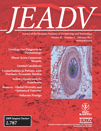Temporary arrest of basal cell carcinoma formation in a patient with basal cell naevus syndrome (BCNS) since treatment with a gel containing various plant extracts
F Tjeerdsma,
MF Jonkman,
JR Spoo,
F Tjeerdsma
Department of Intensive Care, De Tjongerschans Hospital, Heerenveen, The Netherlands
Search for more papers by this authorMF Jonkman
Department of Dermatology, University Medical Centre Groningen, Groningen, The Netherlands
Search for more papers by this authorCorresponding Author
JR Spoo
Department of Dermatology, University Medical Centre Groningen, Groningen, The Netherlands
JR Spoo. E-mail: [email protected]Search for more papers by this authorF Tjeerdsma,
MF Jonkman,
JR Spoo,
F Tjeerdsma
Department of Intensive Care, De Tjongerschans Hospital, Heerenveen, The Netherlands
Search for more papers by this authorMF Jonkman
Department of Dermatology, University Medical Centre Groningen, Groningen, The Netherlands
Search for more papers by this authorCorresponding Author
JR Spoo
Department of Dermatology, University Medical Centre Groningen, Groningen, The Netherlands
JR Spoo. E-mail: [email protected]Search for more papers by this authorNo abstract is available for this article.
References
- 1 Ahmad N, Mukhtar H. Cutaneous photochemoprotection by green tea: a brief review. Skin Pharmacol Appl Skin Physiol 2001; 14: 69–76.
- 2 Morley N, Clifford T, Salter L et al. The green tea polyphenol (-)-epigallocatechin gallate and green tea can protect human cellular DNA from ultraviolet and visible radiation-induced damage. Photodermatol Photoimmunol Photomed 2005; 21: 15–22.
- 3 Elmets CA, Singh D, Tubesing K et al. Cutaneous photoprotection from ultraviolet injury by green tea polyphenols. J Am Acad Dermatol 2001; 44: 425–432.
- 4 Katiyar SK, Perez A, Mukhtar H. Green tea polyphenol treatment to human skin prevents formation of ultraviolet light B-induced pyrimidine dimers in DNA. Clin Cancer Res 2000; 6: 3864–3869.
- 5 Lou YR, Lu YP, Xie JG et al. Effects of oral administration of tea, decaffeinated tea, and caffeine on the formation and growth of tumors in high-risk SKH-1 mice previously treated with ultraviolet B light. Nutr Cancer 1999; 33: 146–153.
- 6 Mantena SK, Meeran SM, Elmets CA, Katiyar SK. Orally administered green tea polyphenols prevent ultraviolet radiation-induced skin cancer in mice through activation of cytotoxic T cells and inhibition of angiogenesis in tumors. J Nutr 2005; 135: 2871–2877.
- 7 Paul B, Hayes CS, Kim A et al. Elevated polyamines lead to selective induction of apoptosis and inhibition of tumorigenesis by (-)-epigallocatechin-3-gallate (EGCG) in ODC/Ras transgenic mice. Carcinogenesis 2005; 26: 119–124.
- 8 Wang ZY, Huang MT, Ferrare T et al. Inhibitory effect of green tea in the drinking water on tumorigenesis by ultraviolet light and 12-O-tetradecanoylphorbol-13-acetate in the skin of SKH-1 mice. Cancer Res 1992; 1: 1162–1170.
- 9 Zhao JF, Zhang YJ, Jin XH et al. Green tea protects against psoralen plus ultraviolet A-induced photochemical damage to skin. J Invest Dermatol 1999; 113: 1070–1075.
- 10 Hebert JL, Khugyani F, Athar M et al. Chemoprevention of basal cell carcinomas in the ptc1+/− mouse – green and black tea. Skin Pharmacol Appl Skin Physiol 2001; 14: 358–362.




